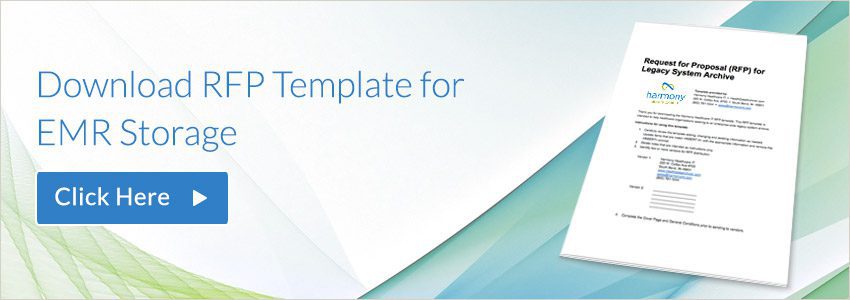
If your healthcare organization recently implemented new software, you probably have older health data systems to decommission and decades-worth of legacy EHR data to store. Writing a request for information (RFI) or request for proposal (RFP) provides a systematic means for both documenting your health data storage needs and vetting vendors who can best meet them. Here are some “request for” document writing tips:
1. Decide whether to issue an RFI or an RFP
Write an RFI if you simply want to gather information about vendors that provide health data storage. An RFI will inquire about archive product features, project management approach, extract-transform-load (ETL) processes, security and encryption methodologies, implementation and training programs, long-term software support services and more. An RFP is a more formal request which clearly states a problem and asks a vendor to solve it. Write a health data storage RFP if – on top of fact-finding — you are able to provide enough detail about the legacy databases to be decommissioned and the clinical data elements to be archived that a vendor could provide a set of recommendations for implementation as well as pricing. An RFP should state the problem to be solved, identify the timeframe in which to solve it and list any budget or deployment requirements for the vendor to meet.
2. State the scope of your project
If you write an RFP for health data storage, go into it knowing that vendors are able to better tailor responses when they are provided with context for the project. Your project scope should include an inventory of systems to be decommissioned. Category headings for your list might include ambulatory practice management systems, ambulatory EMRs, inpatient revenue cycle systems, inpatient EHRs, human resource systems, accounting systems and any other system types (i.e., home health, laboratory information systems, general ledger, etc.) Include database sizes, date of original implementation, number of users, number of locations using the software, dates by which accounts receivables will wind down, dates by which maintenance contracts may be due for renewal and any other relevant information that will help a vendor prioritize its approach for a holistic decommissioning and archiving plan.
3. Establish a timeline for vendors to respond
Setting due dates for each major milestone in the RFI/RFP process allows vendors to plan accordingly with less room for interpretation or negotiation. The vendor’s ability to adhere to established response timelines gives you some insight into their ability to deliver on-time archiving results. Here are some suggested items to include on your timeline:
- Date for release of the RFI/RFP to vendors
- Date by which vendors should confirm their intention to respond
- Date by which vendors may submit clarifying questions
- Date by which clarification will be provided back by you
- Date by which the RFI/RFP is due
- Date by which selected vendors will be invited for an onsite presentation
- If known, date by which a vendor will be selected
4. Explain the submission process and document requirements
So that responses are easier to review by your selection committee, indicate the form and format in which you expect the responses to be returned. For example, do you want the document back in .pdf format or in its native .doc or .xls format? Would you like only to accept succinct answers to questions, or, will you allow vendors to also submit marketing materials as responses? Do you expect only soft copy responses, or, are hardcopies also necessary? If so, what quantity? The more specific you are about your expectations, the more uniform vendor responses will be to make it easier on your team to review and compare archiving solutions. This is especially important in the cases of RFPs. To compare apples to apples, it’s best to provide a format in which each vendor should submit upfront versus recurring solution pricing. Indicate whether you’re looking for pricing by legacy data source or if an enterprise pricing alternative is desired.
5. Write the questions for the RFI/RFP
This is the meat of the document. The more time you spend carefully crafting your questions and requirements for medical data storage, the more likely you will receive meaningful and relevant responses from potential archiving vendors. Here are some key sections to consider:
- Background information – provide an overview of your healthcare organization to include size, organizational structure, technical environment and an end-user summary.
- Company overview – ask the vendor to summarize its organization’s purpose, structure, financial viability, competitive differentiators and uniqueness in the archiving space.
- Product overview – request a description of archiving product features and benefits. If you have specific product requirements, list them on a matrix and prompt vendors to provide codified responses.
- Implementation & training process – ask about options for how the archived data will be deployed as well as the means by which end users will learn how to access it.
- Support and maintenance – gather information to help you understand ongoing costs for software support and maintenance.
- Application and data security – understand how the vendor manages HIPAA data retention safeguards, encryption, data center security, risk mitigation, audit tracking, reporting and disaster recovery.
- Cost Estimate – inquire about license fees, implementation costs, hosting versus on-premise expenses (if applicable), support and maintenance and any other fees that may apply to long-term storage of medical data. Separate one-time fees from ongoing fees. Request a total cost of ownership analysis to understand your return on investment over time.
It takes an experienced vendor to accurately extract, migrate and archive protected health information from an EMR to meet state, federal and/or agency record retention requirements. Writing a well-constructed “request for” document is a good first-step in a process to partner with a reputable and dependable vendor. The comprehensiveness and timeliness of the vendor responses are a tip-off to how the future relationship may lay out.
 Not quite sure about the requirements for your EMR archive or medical data storage project? As EMR replacements and health data volumes increase, medical data storage archives are on the rise. That doesn’t mean, however, that you’ve created a EMR legacy migration and decommissioning team or are executing on a legacy data management strategy. If you are in the initial stages of strategy development and need of more information about the archiving process prior to writing your RFI/RFP for medical data storage, contact us. We may be able to get you started with a health data archiving RFI/RFP template.
Not quite sure about the requirements for your EMR archive or medical data storage project? As EMR replacements and health data volumes increase, medical data storage archives are on the rise. That doesn’t mean, however, that you’ve created a EMR legacy migration and decommissioning team or are executing on a legacy data management strategy. If you are in the initial stages of strategy development and need of more information about the archiving process prior to writing your RFI/RFP for medical data storage, contact us. We may be able to get you started with a health data archiving RFI/RFP template.
Editor’s Note: We’re reposting this blog as we continue to see a need to provide tools to help healthcare providers outline their health data storage needs as well as compare vendors to determine which company can best support them.






